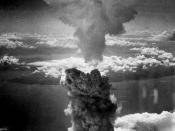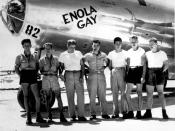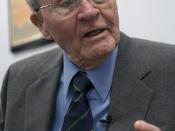In August of 1945, the United States dropped two atomic bombs on Japan. The first, called "Little Boy," was dropped on Hiroshima on August sixth. Three days later, on August ninth, "Fat Man" was dropped on Nagasaki. The two consecutive bombs, and the horrific effects that they wrought upon the people of Japan, succeeded in ending World War II. The plane that dropped the first bomb was called the Enola Gay, after the pilot's, Paul Tibbet's, mother. The second plane was called Bock's Car, after its usual commander, Frederick Bock; it was, however, flown by Charles Sweeney on during the fateful bombing run because Bock was flying one the observation planes (Baugher 3). The decision to use these two incredibly powerful bombs was not made lightly, but with heavy thought and the culmination of many events.
On December 7th, 1941, Japan attacked Pearl Harbor, a United States military base in Hawaii.
Although the U.S. had wanted to stay neutral and out of what soon became an intense global conflict, this disgraceful attack brought the unwilling country into the war. The following day, December the 8th, the U.S. and Britain declared war upon Japan (Pearl Harbor 3,4). For the next three and half years, World War II raged throughout the eastern hemisphere. Finally on May 7, 1945, the Germans unconditionally surrendered of all their forces to the Allies, thus ending the war in Europe. The war with Japan, however, continued, because Japanese military wanted to fight to the bitter end and vowed to never surrender. It was not until the bombings of Hiroshima and Nagasaki, however, that the entire war was brought to its very much needed end.
In all of my previous research of the atomic bombings and World War II, I have learned about the pilots who flew...


